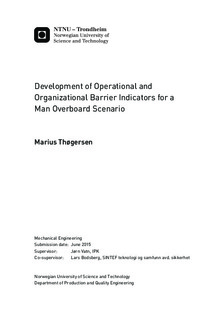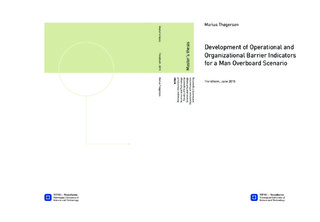| dc.description.abstract | For years, minimizing accident risk by managing operational and organizational barriers have been a top priority for the Petroleum Safety Authority Norway. This holds true for 2015 as well, and this report is aligned accordingly.
Three recent reports have been reviewed to investigate the chaos of terms surrounding barriers. Each report suggests a classification for barrier elements with corresponding definitions. Based on a pros and cons study, the most suitable classification was selected to use in the case study. It was decided to use three classes of barrier elements; organizational (personnel with defined roles and functions), operational (the description of actions or activities carried out by the personnel) and technical (equipment and systems). Relevant parts of the case study was used as examples to provide context to the selection process.
Literature reviews of recent projects and articles were conducted to determine the most commonly used performance influencing factors and indicator evaluation criteria. The results were applied in the case study.
A theoretical foundation for a man overboard (MOB) case study was created by investigating the basics of MOB accidents. The case study was limited to man overboard accidents during planned work over open sea. Preconditions and required safety measures for work over open sea was investigated, and an examination of how required MOB preparedness is kept was conducted.
The case study was carried out to investigate barrier functions, and especially operational and organizational barrier elements. Models and illustrations were created to effectively communicate intermediate analysis results step by step. Both the phases leading up to a MOB accident, and the phases succeeding a MOB accident were investigated. Most time and effort were used to investigate the latter. Knowledge gained from the earlier literature reviews were applied. It was chosen to focus solely on the consequence reducing "rescue and recover" barrier function. The MOB-crew was determined to be the most important organizational barrier element for this function, and their ``fluctuating'' competence was determined to be the main performance influencing factor. The main result was the development of a set of three indicators to monitor the MOB-crew's competence (developed through a series of workshops with a collaborating oil and gas company):
1. Fraction of MOB-personnel with valid certification.
2. Fraction of successful exercises.
3. Fraction of successful exercises conducted close to maximum allowed weather conditions.
Because of the rather narrow focus, the findings might not be as valid for the overall MOB scenario, as they are for the specific "rescue and recover" barrier function.
All in all this report contributes by defining a set of indicators to monitor organizational barrier elements. The report also makes considerable contributions towards formalizing barrier functions, barrier elements and performance influencing factors in a MOB scenario. Due to time restrictions, a set of indicators for operational barrier elements was not developed. | |

